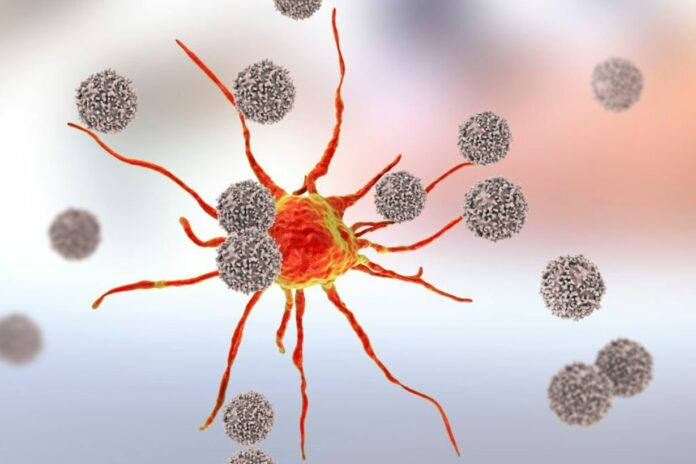A cell’s surface contains tens to hundreds of thousands of chemicals that enable immune cells to identify friends from foes. Some projecting molecules are antigens that stimulate the immune system to attack, but it can be difficult for scientists to locate them in the molecular forest.
A new technique to more quickly and correctly anticipate which antigens will trigger a powerful immune response has been created by a team of Stanford researchers led by Polly Fordyce, an Institute Scholar at Sarafan ChEM-H. Their method, which was detailed in an article published in Nature Methods today, could help researchers in the development of more efficient cancer immunotherapies.
T cells, a kind of immune cells, crawl and squish past other cells as they patrol the body, employing T cell receptors to molecularly detect peptides contained within bigger proteins called major histocompatibility complexes (pMHCs). When T cells identify disease-indicating peptides, they get activated to seek out and kill cells carrying these foreign signatures in the body. Healthy host cells exhibit a variety of pMHCs that do not initiate an immune response. It has long been unclear how T cells sensitively differentiate these antigenic peptides from host peptides to prevent unintentionally harming host cells.
According to Fordyce, an assistant professor of bioengineering and genetics, “a T cell can detect a single antigenic peptide among a sea of 10,000 or 100,000 non-antigenic peptides being displayed on cell surfaces.”
The T cell crawl holds the secret of selectivity. The bindings between receptors and peptides are stressed as a result of T cells sliding, and in most situations, this additional stress is sufficient to break the bond. However, occasionally it has the opposite result. Professor of molecular and cellular physiology and structural biology Chris Garcia, a research co-author, and others have previously demonstrated that the most antigenic peptides are those whose interactions with T cell receptors intensify in response to sliding.
“It’s kind of like a Chinese finger trap,” remarked Fordyce. “When you pull a bit at the receptor-antigen interaction, the binding actually lasts longer.”
To find the best antigen-receptor pairs, a sliding, or shear, force must be applied between a peptide and a T cell while measuring T cell activation, ideally thousands of times to get repeatable data for many possible peptide/T cell receptor pairs. However, current techniques are laborious, and at the end of the day, you could only have measured one peptide with hundreds of T cells.
The team was able to assess 20 distinct peptides interacting with hundreds of T cells in less than five hours thanks to a technique created by the study’s first author, postdoctoral researcher Yinnian Feng.
To make a simplified system that looks like cells with dangling peptides, they made small spherical beads out of a material that expands when heated and stuck a few molecules of a given peptide-studded pMHC onto their surfaces. They placed a T cell on top of each bead and allowed enough time for the receptors to attach to the peptides before mildly heating the bead. The T cell is stretched to simulate the force it would encounter sliding over body cells as a result of the bead’s growth, which widens the space between the tether points. The scientists then measured the T cells’ level of activity after applying that force.
Using beads that are each marked with a different color, they could do hundreds of separate experiments at the same time, making it possible to track many different pMHCs. After each run, they captured two sets of images that were tiled across each slide: one set that revealed the pMHC a specific bead was displaying, and another that revealed the level of activity of each T cell above that bead. By cross-referencing those images, they were able to determine which antigens caused the T cells to respond most strongly.
The team used 21 different peptides to demonstrate their platform, demonstrating that their findings supported the existence of known activating and non-activating peptides for one T cell receptor as well as the discovery of a previously unidentified antigen that elicited a potent T cell response. Working with the Garcia lab, they have also started to solve a problem in immunotherapy: the T cell receptors that interact most strongly with antigens in the lab are often also activated by non-antigenic peptides in the body. This is a dangerous side effect that kills healthy cells. The group used their method to describe T cell receptors modified to detect tumor antigens with minimal off-target response. In the future, they want to make libraries with more than 1,000 peptides to find new antigens.
They believe that this method, which is rapid and only needs a small number of cells, or an improved version of it, may one day be used to enhance customized immunotherapies.
In addition to identifying which antigens are capable of potently activating a patient’s own T cells to more efficiently target cancer cells, this platform can help improve attempts to create T cells that selectively target cancer cells, according to Fordyce.
Image Credit: Getty
You were reading: New Trick Could Help Trigger Specific Immune Cells, Say Scientists
